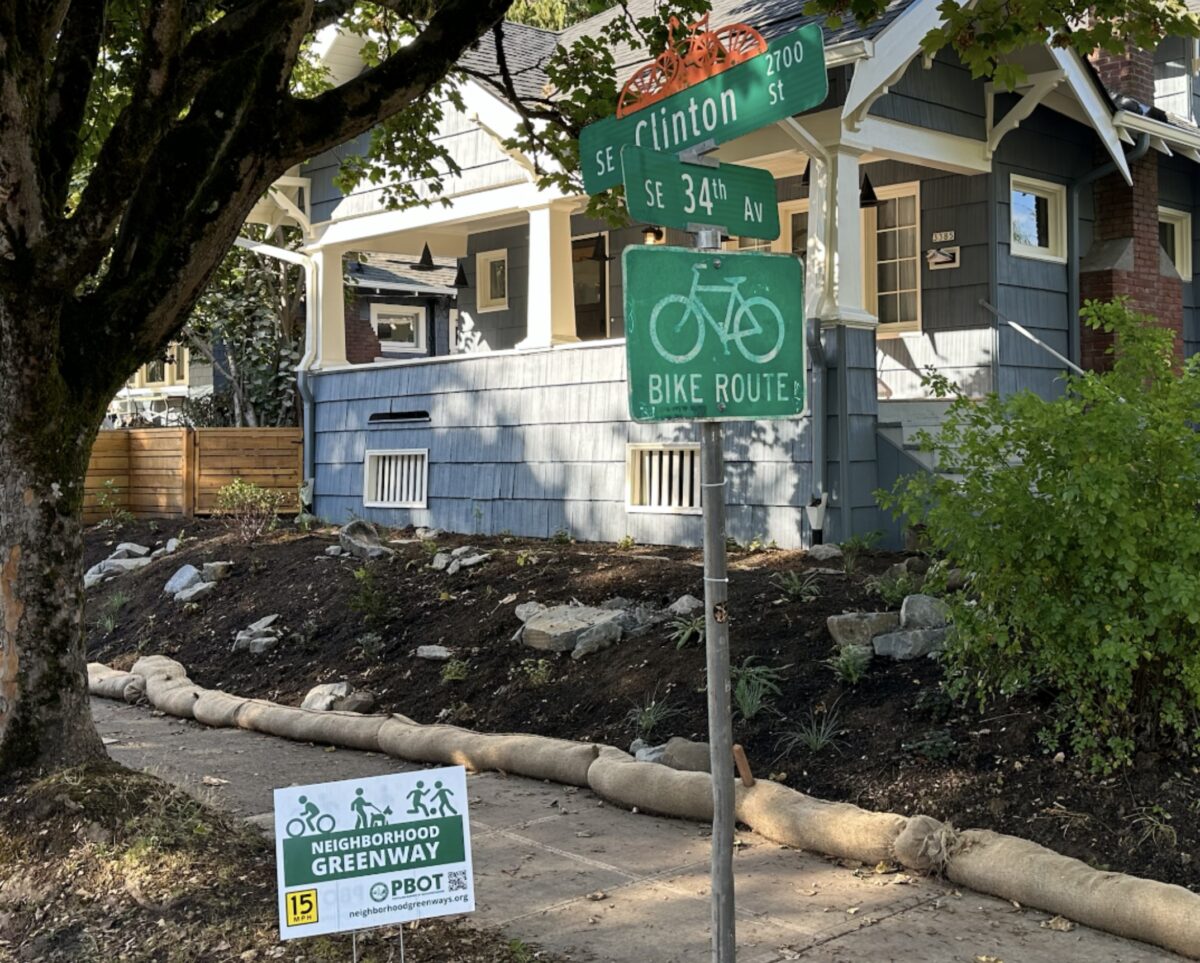
“One of the beautiful things that could happen if the wayfinding was right would be that you could just go out and explore.”
-Aaron Kuehn
There are two kinds of people in the world: map people and non-map people. I am a proud map person (as I imagine many BikePortland readers can relate to) – I have always been fascinated by visual representations of geography, and I love giving directions and planning out routes. But regardless of your personal interest in maps, everyone needs some kind of navigation tactic to move around the city.
For people who bike or use other modes of active transportation to get around, a sound navigation strategy is especially important. But the way Portland is designed, creating that strategy requires a level of exertion that not everybody has the time or energy for – so they end up driving instead. This is something advocates want to change.
Some members of the non-profit advocacy group Bike Loud PDX have taken on an effort to improve Portland’s bike wayfinding system. Bike Loud member Aaron Kuehn is the de facto leader of project. He wrote an extensive report detailing Portland’s current bike wayfinding system and offered suggestions for improvement. The report is still in progress, but I took a look at what Kuehn has written so far and was intrigued by what I saw.
When I talked to Kuehn about his interest in bike wayfinding, he said a lot of it stems from his work doing graphic design. Kuehn is a graphic designer by trade, so he spends a lot of time thinking about the best way to create visual depictions.
“This is at the intersection of things I’m really interested in – visual communication and bike advocacy,” Kuehn told me.
Kuehn wants to use his skills as a designer to help change people’s transportation habits. He thinks it’s a pragmatic approach to making the best of the bike network we have instead of waiting for the right infrastructure to be built on every street in the city.
“A world class bicycle wayfinding system can be designed and installed in a short period of time, and requires far less funding than concrete infrastructure,” the report states. “You probably have developed your own routes for getting around town efficiently, but in order for a public way or route to usefully exist, it must be commonly identifiable.”
“What I’m trying to do is use the network that we already have and make it more accessible rather than changing the configuration of the streets, right? Step one with wayfinding is just taking what we have and squeezing it for all we can get out of it,” Kuehn told me.
What is wayfinding?
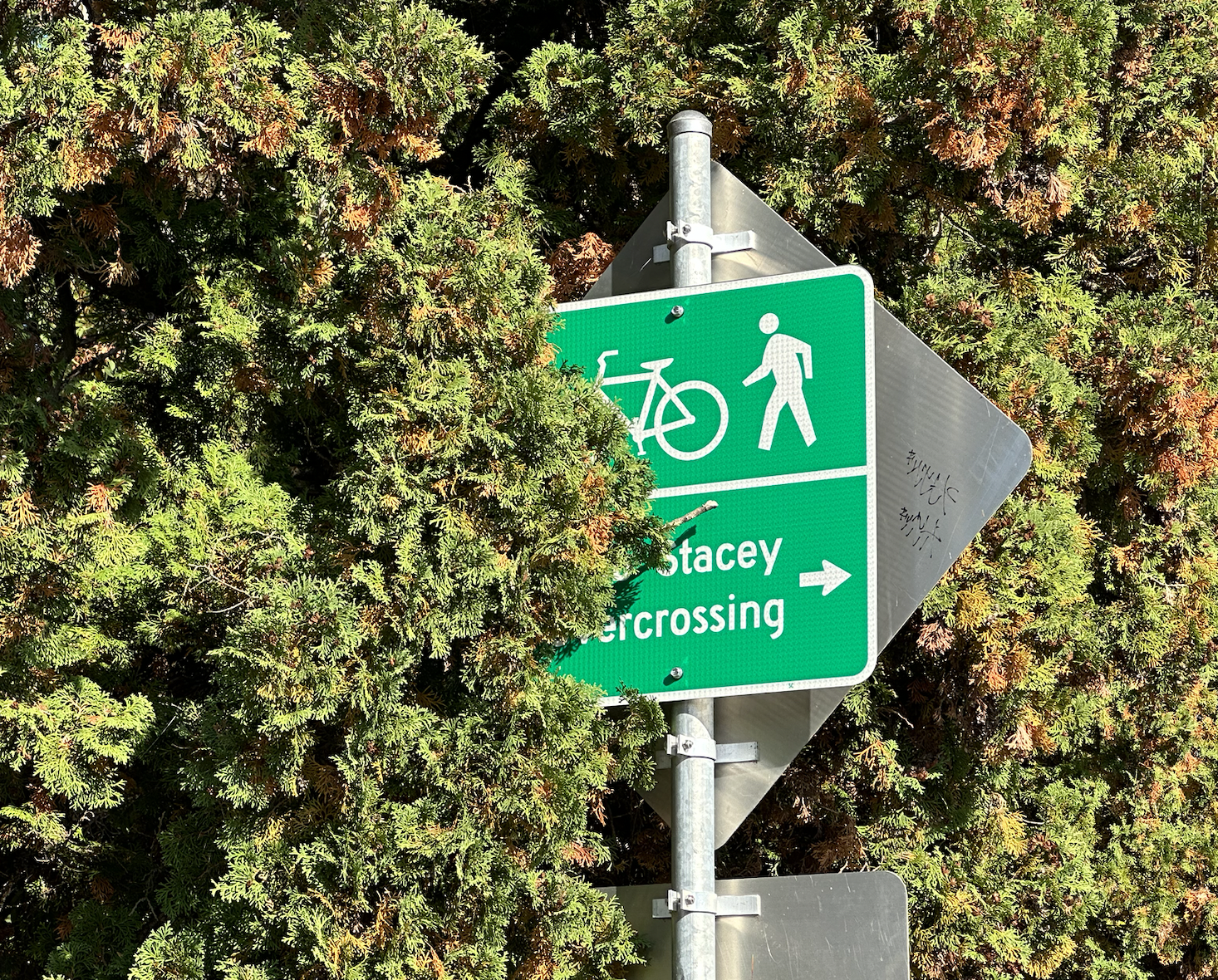

In the report, Kuehn describes wayfinding as “the primary education and communication medium for reaching street users.” The report continues:
Thoughtful wayfinding can reduce psychological barriers to modeshift, by inclusively inviting new beginner users. Wayfinding establishes a trust relationship, where the care that went into creating the wayfinding system communicates a concern for the safety and wellbeing of the user and is commensurate with the quality and care embodied in the infrastructure and route planning. The user chooses to follow the wayfinding because it is reliable.
The Bike Loud report explains the three main forms of bike wayfinding we use in Portland right now. These are:
- Sharrow pavement markings: Painted bike symbols used to indicate when people are on a neighborhood greenway with arrows marking which direction they should turn to stay on the greenway. This system was developed in Portland and is not nationally recognized as a wayfinding strategy, but it works well to guide people through the greenways. The report says this is “the closest thing Portland has to a comprehensive marked bicycling network, but because they only apply to greenways they are limited as a universal wayfinding tool to connect to other types of cycling infrastructure.”
- “D series” guide signs: Named “D series” because they provide destination, directions, and duration to nearby popular locations. The report states these are overly complicated and try to convey too much information at once, and would also not be helpful to someone who isn’t familiar with Portland neighborhood names.
- Neighborhood greenway “confidence” signs: These indicate to people biking and driving that they’re on greenways, and they’re currently few and far between. The report states that “it is likely that many potential users do not use greenways because they do not know they exist or where they are located. A confidence sign in the middle of every block, and new signage posted at greenway junctions, junctions with all bikeways, and junctions with arterials will increase awareness of greenways.”
These don’t take into account temporary or non-fixed signs. The Portland Bureau of Transportation has handed out greenway yard signs to people who live on the routes as a community wayfinding effort. But these are flimsy and can be removed at the discretion of the people who put them up.
Something else that may help with wayfinding: green paint. The newer green pavement treatments popping up around the city (on the Naito and Greeley bikeways and all around the South Waterfront) weren’t necessarily done with wayfinding in mind, but it could be used for that purpose. Kuehn says this “could possibly be the gold standard for confidence marking” and is “an easy to follow system without any abstract thinking.”
The report has some suggestions for expanding on the wayfinding elements we already have to make the system more robust. These include route signs, which would name and identify the well-established routes people use to bike around the city akin to the route signs used on highways, and a bicycle node network focusing on directing people toward connecting bike routes instead of long continuous bikeways.
As we touched on in a recent story about greenways near Hawthorne Blvd, advocates also want to make sure people know about bikeways when they’re on main streets (like Hawthorne) that don’t have dedicated bike facilities. This will require signage and education on all streets, not just the greenways, but it’s a very important aspect of helping people navigate the city by bike.
Breaking habits to achieve critical mass
Kuehn thinks people default to using cars to get around because it’s what they’re used to. In order to encourage more people to bike, we need to throw a wrench in that process.
“The system is designed for you to drive a car. All the advertising is telling you to do it, everyone else is doing it,” Kuehn told me. “And people will do everything possible to not change their routines.”
If you make a wrong turn while driving a car, it’s not usually a big deal: wandering around in a car won’t physically tire you out, and you’re unlikely to come upon a street that’s inhospitable to your mode of transportation. While biking, however, you need to preserve your energy, not waste it by going around in circles. And if you end up in an area filled with dangerous arterials and no bike infrastructure to speak of, you could end up seriously hurt. Most people don’t want to find themselves in this situation.
Bike Loud’s key mission is to get Portland to a 25% bike mode share by 2030. This is going to require a tremendous shift and will mean bringing people into the fold who currently don’t feel safe enough to bike often.
“[Achieving the 25% mode share will require] bringing in people who are concerned for their safety, who aren’t in the bike community already and don’t have friends who are,” Kuehn said. “What is it that’s going to nudge people to feel empowered and know they can do it?”
A key tenet of the movement to get people out of their cars and onto bike seats is that the popularity of biking creates a feedback loop. More people biking means less cars on the road and thus, less potential for danger, which bike-wary people will notice and may be inspired to start doing it themselves.
“If we can shift the mode, it’s going to make it safer for everybody,” Kuehn said.
The path forward
Some might take an issue with Kuehn’s philosophy for not demanding enough from the city. To people who think having protected bike lanes on Portland’s main streets is crucial for achieving our mode shift goals, this might seem like a way to let the city stick to the status quo of relegating bike riders to the back streets.
But I don’t think it has to be either/or. We shouldn’t have to choose between asking our leaders to prioritize active transportation in our cities and using the infrastructure we already have to the greatest extent possible. The more people we can get on bikes right now, the better – and eventually, that could very well mean taking up more real estate on commercial streets that are currently very dangerous to bike on.
Kuehn isn’t totally sure how he and the rest of Bike Loud will move forward with their wayfinding report – they’re still hashing out their plans for how to implement these ideas. Regardless of what happens with this report, however, I think this is a really interesting topic for people to think about while they bike around the city.
A big part of the reason I love biking so much is because it helps me carve out an internal map of my surroundings and center myself in space. I’ve only lived in Portland for a little over a year, but since I spend so much time thinking about and using the streets all across the city, I feel like I’ve been here longer. Everyone should have the opportunity to feel this connected with the place where they live.
“It should be possible to be spontaneous,” Kuehn said. “One of the beautiful things that could happen if the wayfinding was right would be that you could just go out and explore.”



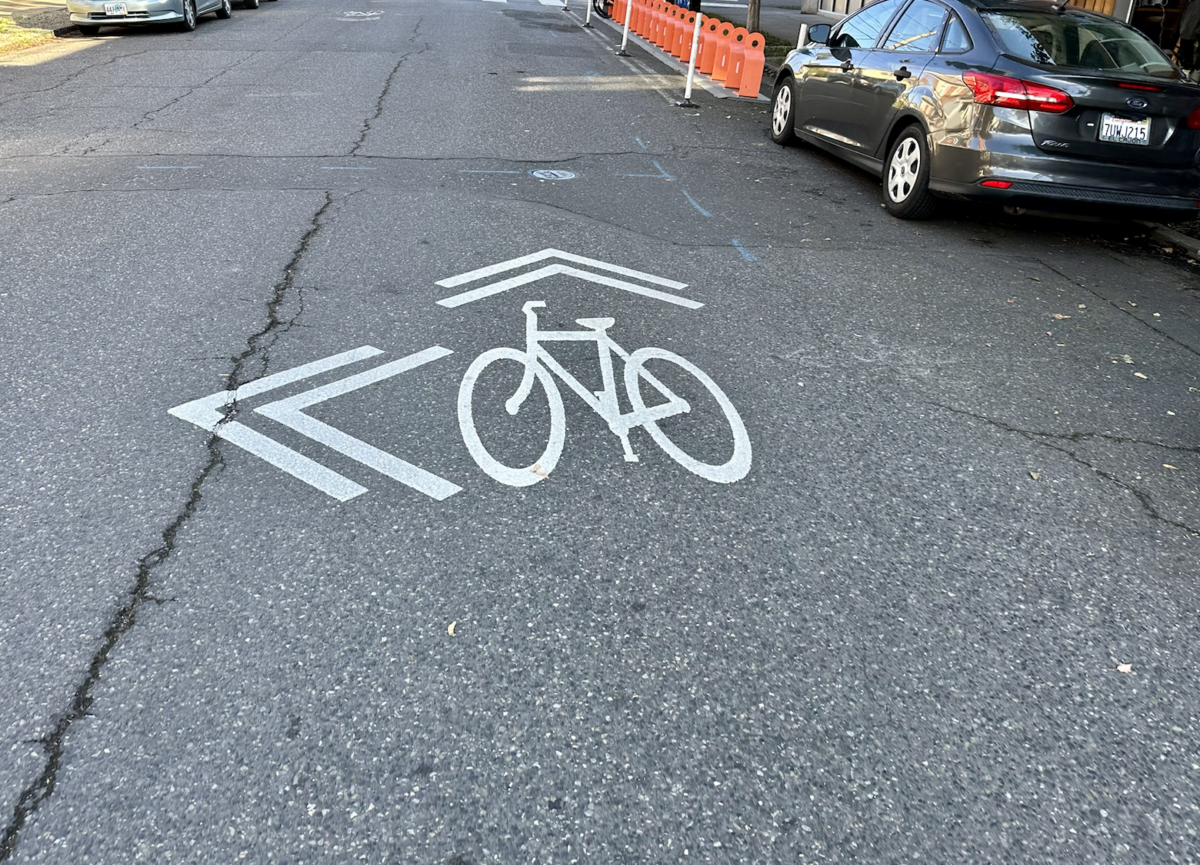

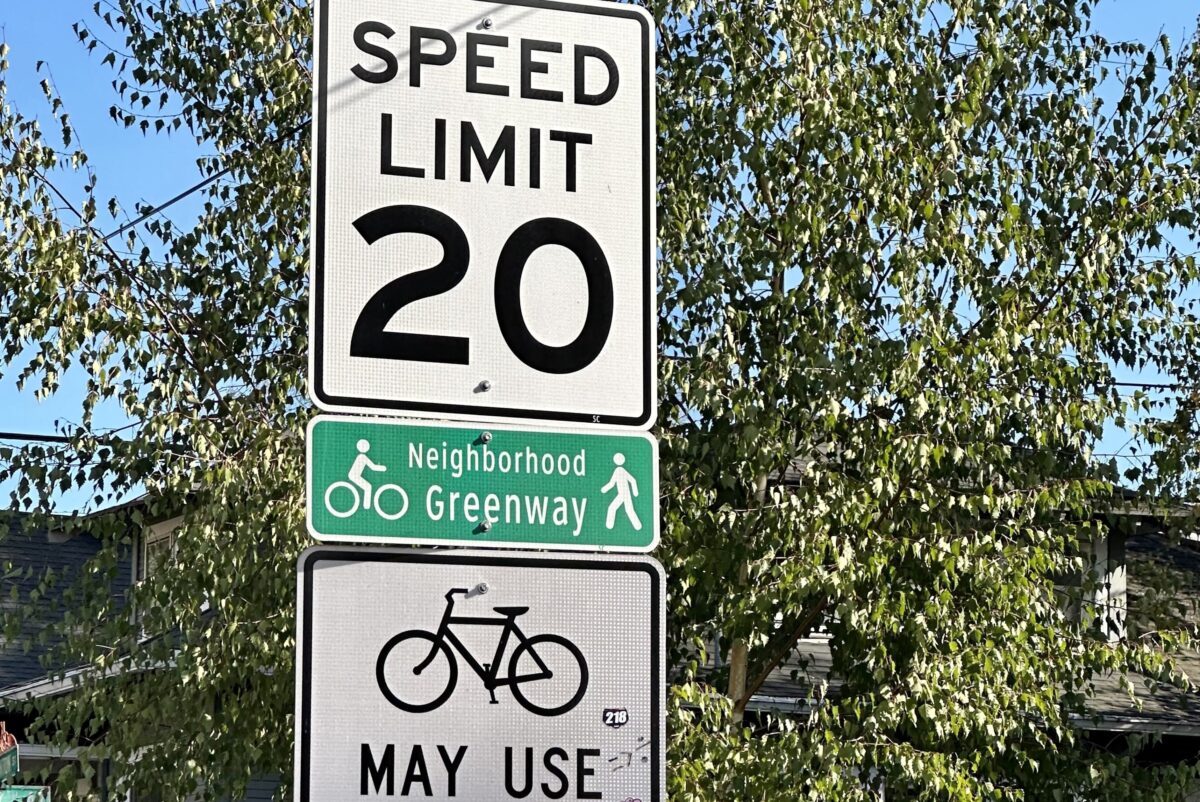
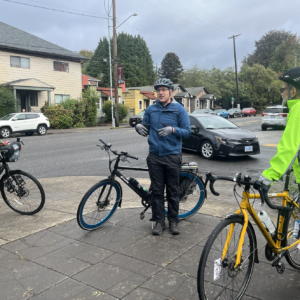
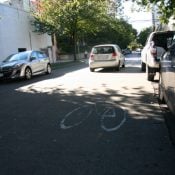
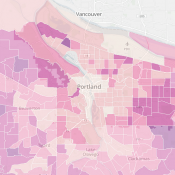
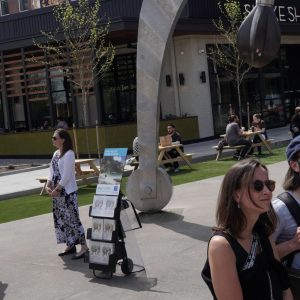
Thanks for reading.
BikePortland has served this community with independent community journalism since 2005. We rely on subscriptions from readers like you to survive. Your financial support is vital in keeping this valuable resource alive and well.
Please subscribe today to strengthen and expand our work.
People drive so much because its easier and more convenient, not because there aren’t little signs everywhere.
and yet car signs are easier to see, even in intersections where the speed difference between bikes and cars is negligeable. It’s just one more way in which car culture shows its dominance.
You’re right, pigs – people are lazy. Let’s celebrate that fact! – and enable people’s worst tendencies by privileging cars over all other modes of transportation.
(Oops! I must have lifted a line from the ODOT playbook.)
Bike love, bike culture, and bike ambassdors and other carrots have worked so well to “shift” people out of their
carsSUVs. People like pigs who suggest that we should make it less easy and less convenient to drive are just negative nabobs negativism. I’m sure SUV mode share will plummet if we extend pedalpalooza by another 2 months and smile and wave at drivers.This goal reminds me of extinction rebellion’s demand of net zero* by 2025.
Census ACS 2021 cycling mode share in Portland: 2.8%
Census ACS 2021 cycling mode share with “work from home” subtracted out: 4.4%
*We need science-based zero, not a “net-zero” based on imaginary corporate carbon-trading and offsets.
You’ve used a lot of words to say nothing. Congrats.
Let me spell it out for you:
The likelihood of Portland achieving 25% cycling mode share in ~8 years is asymptotically close to zero. Making this demand a key part of an org’s goals is an exercise in wishful thinking and creates an impression of epistemic closure.
Transportation cycling is in crisis and no one here on bike portland (or at BikeLoudPDX) even wants to talk about it.
I’m sorry you found no meaning in this, Will; I did. Whether I agree or not (and I do), it is a very clear position to me.
Thanks for covering this important issue! I hope that there will be a renewed interest in the wayfinding videos I made for my Bike Stuff PDX YouTube channel.
https://youtu.be/tTn7U4JKttQ
“A big part of the reason I love biking so much is because it helps me carve out an internal map of my surroundings and center myself in space. I’ve only lived in Portland for a little over a year, but since I spend so much time thinking about and using the streets all across the city, I feel like I’ve been here longer.”
So true! A bike offers a great speed for learning a new city: it’s more efficient than walking, yet not to fast as a car, which doesn’t allow one to see as much while traveling.
I LOVE that local cyclists are directed to “Clint”…as in Clint Culpepper’s home.
[I mean whom else would that be in Portland’s bike culture?! ;-]
YES let’s go to Clint’s house! And the birth story of those particular markings…
“‘This was a new intersection that should have been designed for people walking and biking and driving from the beginning. Unfortunately, the bicycle signal was an afterthought and it wasn’t done right.’”
“Kocher said the city should give bicyclists a separate traffic signal altogether from the buses. Portland doesn’t have plans to do so.
“As part of the settlement, Kocher said the city agreed to install a new bike traffic signal on the eastern side of the intersection. The city will also add dotted lines and striping and signage to clearly indicate how bicyclists can travel through the intersection and head south onto Milwaukie and install new signs on both sides of the intersection to alert bus operators and bikes of the traffic flow there.’”
https://www.oregonlive.com/commuting/2019/09/portland-pays-145000-to-end-legal-fight-over-2015-bike-trimet-collision-at-complex-intersection.html
This is great article and an exciting effort by BikeLoud! I would add a couple of throughts: When I drive, I can plug a destination into my phone and I will get the most efficient directions dictated to me in surround sound. The cycling directions are never safe or direct and I cannot hear them- so I rely on reviewing a map, then watching for signs. At night, I am usually on my commuter witha generator hub and a german headlight that is bright and illuminates the road well, but it has a cutoff to not blind other riders. This means I cannot read the street signs for navigation. I would like to see a couple of trials: 1) black letters on a white background for street signs along greenways, 2) paint the cross street on the street ahead of the intersection. I think putting wayfinding on the street is great idea!
I remember reading about a temporary park/route in Boston. While they waited fo design and build it, they painted a line to mark the route so people could start to use it and notice it. It would amazing to paint a dashed green line down the center of every greenway!
The biggest challenge PBOT has is a complete lack of commitment to designing greenways. A simple/direct route is incredibly important for users to build a mental map of a bike network. PBOT’s eagerness to compromise bike routes for any reason makes bike routes that zig and zag,and jog and stop and start to sucha ridiculous extent that you need pages of printed instructions to just ride across town. PBOT needs to commit to simple, direct bike routes to build a useful bike network (NW Overton and NE 7th are 2 recent example of PBOT failures)
Thanks for these constructive thoughts. The German headlight regulations are a funny curveball, consider switching to a blinding American headlight. Sometimes German wayfinding is in the form of a “padstool” low to the ground, but mostly in rural areas. Your dashed green line on greenways suggestion is directly in the BikeLoud Wayfinding recommendations already. Either dashed or solid or a line or a lane, but continuous – yes! Simple, direct, useful, network – Yes!
Aaron, I notice the comment about mapping software not always choosing bike-ways or bike friendly routes. Have y’all thought about contacting the mapping companies (e.g. whoever does the grunt work for Google Maps, etc.) and provide them with a detailed network of preferred bike routes through the city?
Or PBoT could return to an old standby that still exists in many locations in the region (Vancouver as them too) but has fallen out of favour due to car headlamps being so powerful now & “maintenance costs” for filament bulbs: the internally lit arterial roadway name sign. Update the remaining ones with LED bulbs!
They would help pedestrian too…as my eyes are not as good as they once were AND some of the suburban intersections are soooo large that it can be difficult to read some street name signs.
See attached sample of internally lit sign once common in region.
“A simple/direct route is incredibly important for users to build a mental map of a bike network.”
With only a few exceptions, I’ve found navigation by bike around Portland to be easier and more direct than navigation by car. Most of the destinations I go to seem to have relatively direct routes. Is there really as problem?
Maybe it’s easy for me because I totally ignore the greenway system and instead chose logical routes.
Give me a break, Watts. Some NGs are tortuous routes of slowness (much of the 20s) but others are the most efficient way to get from point A to B (e.g. lower Clinton or Lincoln-Harrison). We need more of the latter and none of the former.
I like the dashed line or some kind of ground based wayfinding. However,I imagine pbot would be resistant to the use of center lines on greenways. I think they believe that center lines facilitate higher motor vehicle speeds.
When it comes to signage on greenways, all I want is simple, utilitarian signs that are destination agnostic. For example, “30’s bikeway Northbound” or “4M Bikeway Westbound.”
Those are called “route signs,” and they are the first recommendation in the BikeLoudPDX wayfinding analysis. Plenty of other US cities use route signs, ODOT uses them, they are standardized, and really incredibly useful. More developed wayfinding systems often have guide (destination) signs, route signs, confirmation markers, mile markers, and more – all coexisting. People use the bike network and wayfinding in different ways, but for efficient distance travel following identified routes is sensible. The Portland 2030 Bike Plan (which is more than 10 years old) asks for route signs, and PBOT’s progress report in 2019 gives no explanation for why they have not been implemented.
These are the signs I want:
SUVs/personal-trucks/(cars) are guests.
No passing bicycles.
Speed limit: 15.
And perhaps “two-wheeled zero-emission vehicles only”
That leaves out tricycles, and other non-standard bicycles.
Where greenways meet side streets:
Crossing Traffic Does Not Stop.
That’s an actual sign that exists. My real sentiment would be more of a paragraph and it can’t all be reproduced here.
That’s a good one. Too many SUV drivers crossing NGs behave as if their hurry is more important that their vulnerable neighbor’s health/life.
Taylor, thanks for covering this important subject! I’m also fascinated by visual representations of geography. One of my sons works with GIS (ESRI) data, so I’ve come to appreciate the many layers (pun intended) of meaning that can be applied to maps today. (He’s also my go-to for help with PhotoShop. )
Wayfinding was one of the topics I studied when I learned about human-centered design principles in an information design course I took in grad school. We talked about the effects on people who are sight impaired, don’t comprehend some languages, can’t tell certain colors apart, and so on. From an active transportation standpoint, I found the “look for the worn paths to grass when you build a sidewalk” example helpful.
Aaron, if you haven’t already referenced in your report, I’d like to put in a plug for our Living Cully wayfinding signposts, which include helpful information for those of us who now walk. Here is an example – https://www.flickr.com/photos/memcclure/48818352547/
in the grass
The achilles heel of ALL bikeways is signage.
Alas, this lack is nothing new. In the 90’s when the advisory committee for the Tillamook “Bikeway”…if you will…was in the thick of it, we spent several meetings dreaming up signage to make the route easily known to both cyclists and motorists. We were inspired by what had been done in Vancouver BC. None of our ideas were adopted, and the route remained a great secret for years!
Finally, the inspired “Bike Dots” appeared…what a joke! Then Sharrows, which are really meant for shared routes, not predominately bike routes. And last but not least, destination signs which are small enough to make you slow and discover how inaccurate they are! Concordia University? dead two years, but still a noted destination. No vision, no guts, no maintenance; just the same old focus on keeping traffic moving and sinking the planet. Good luck and thanks to Bike Loud!
Nope, nothing new.
I’m like you, Taylor: I plan my route on a map and am surprised by wayfinding signs – I don’t really need them. They are confirmatory for me, and that is all. I don’t think I’d miss them if they disappeared.
I like maps, I just have a really hard time reading them sometimes.
With a few exceptions like the Esplanade, Portland’s bike routes aren’t game changers for trips of three miles or more. Signs help a person find tailored street crossings but often they also lead to adverse grades and scrappy pavement. Greenways take you over a dozen gratuitous humps in a mile. They wander.
I’d like to see some signs pointing out bike routes that junketing Euros would hire a sailboat to come over and see if it’s real and ride around with silly smiles.
“If you make a wrong turn while driving a car, it’s not usually a big deal”
Uhh … not based on my observations of average drivers when they mess up. I regularly see them turn from the wrong lane, or try to force themselves into the dedicated lane they forgot to get into at the point where it’s technically illegal to do so. That and the number of illegal u-turns directly in front of me on greenways are pretty out of control.